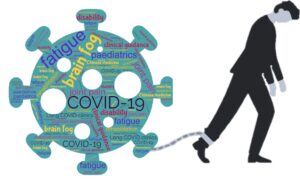As we continue to navigate the complexities of the COVID-19 pandemic, a new term has firmly embedded itself in our medical and social lexicon: Long COVID. This condition, also known as post-acute sequelae of SARS-CoV-2 infection (PASC), represents a perplexing and concerning aspect of the coronavirus’s impact.
The Elusive Nature of Long COVID
Long COVID is characterised by symptoms that persist long after the acute phase of the COVID-19 infection has subsided. Unlike the initial infection, which typically resolves within a few weeks, Long COVID lingers, often leaving individuals grappling with an array of symptoms for months.
A Spectrum of Symptoms
The symptoms of Long COVID are diverse and can affect multiple organ systems. Some of the more commonly reported symptoms include:
- Persistent fatigue
- Shortness of breath
- “Brain fog” or cognitive impairment
- Chest pain
- Joint pain
This variability in symptoms makes Long COVID a particularly challenging condition to diagnose and manage. It’s a bit like a chameleon, changing its appearance and impact from person to person.

Who is at Risk?
One of the more puzzling aspects of Long COVID is understanding who is at risk. It seems to affect people regardless of the severity of their initial COVID-19 infection. Young, old, those with mild cases, and those who were hospitalised – all have reported experiencing Long COVID symptoms.
The Impact on Daily Life
The implications of Long COVID are profound. It’s not just about managing ongoing health concerns; it’s about how these symptoms interrupt daily life. People with Long COVID often find themselves unable to perform their usual work, engage in social activities, or even complete simple household tasks.
The Quest for Treatment
Currently, there is no one-size-fits-all treatment for Long COVID. The approach is largely symptomatic, focusing on managing individual symptoms. This might include physical therapy for muscle weakness, medication for pain relief, or cognitive exercises for brain fog.
The Ongoing Research
The medical community is actively researching Long COVID to understand its causes, mechanisms, and potential treatments. It’s a puzzle that scientists worldwide are diligently working to solve, given its widespread impact on populations.
Living with Long COVID
For those living with Long COVID, it’s a journey of patience and adaptation. It’s about finding the right balance of activities, understanding personal limits, and seeking support from healthcare providers, family, and friends.
Conclusion
Long COVID reminds us that the implications of the COVID-19 pandemic are far-reaching and still unfolding. It underscores the importance of preventive measures like vaccination and public health guidelines to reduce the risk of COVID-19 and its long-term effects. As we continue to learn more about Long COVID, the hope is for better management strategies and, ultimately, solutions to prevent and treat this perplexing condition.




